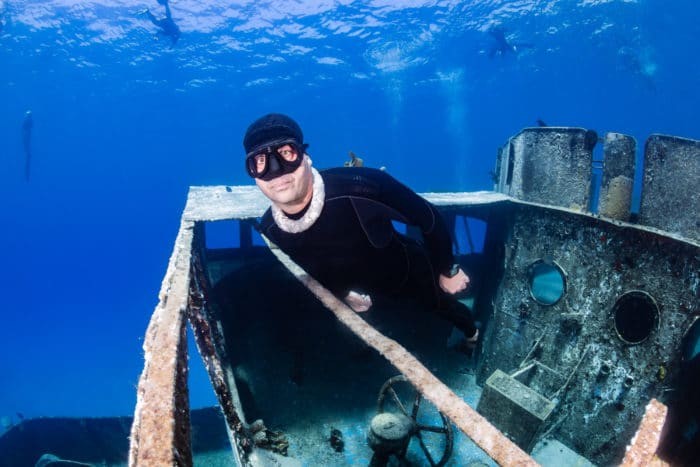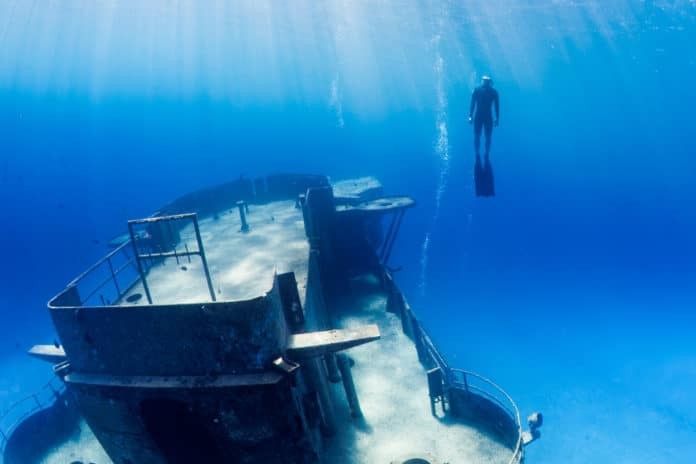Freediving does not have to be all about going up and down a line, journeying into our own mind, or training non-stop. You can put those freediving skills to good use, especially when you are on vacation near a shipwreck. You have the advantage over snorkelers by being able to get up close and personal with the wreck, while also taking prettier photos than scuba divers with bulky equipment. So how can you explore these wrecks safely?
Know the conditions
Fun diving of any kind in open water comes with risks. This means you need to know the conditions of the sea: visibility, current, wind, waves, boat traffic, etc. These dives need to be planned with care, and if there is a possibility of hiring a guide or going to a local freediving shop and having an arranged trip with them, take it. Even if you just ask for advice, they might know when the current is at its weakest, if there is uneven current, how much boat traffic there is, or any other important conditions you need to be aware of.
Bring a buoy
A buoy is essential for a proper breathe-up and recovery breathing; it keeps you in place, provides surface support, and will act as a surface marker for boat traffic. It can also hold a line if you are exploring a deep wreck, in which case you can lower the line and go down free immersion, which can give you more time to explore the wreck. You can also use the line to guide you to a certain area of the wreck, and use it on your ascent.
Dive to manageable depths
When freediving off of the line, it is always safer to go no deeper than one-half or two-thirds of your personal best. For example, freedivers who go to 40m (131ft) should dive no deeper than 20-30m (65-98ft), and a 20m (65ft) diver should stay at or above 10-15m (32-49ft). This will keep you from pushing your limits and encourage more safe and comfortable dives.
Always have a buddy
Safety becomes much more of an issue when you are diving off of the line, and this is when it is even more important to never freedive alone. Even if you are with a large group of snorkelers and want to take a closer look at a wreck, remember that none of those snorkelers will be able to reach you if you have a blackout unless you float up to the surface. And even then, it is highly unlikely they will know how to help a blacked out freediver recover. A proper buddy is a trained freediver who is knowledgeable about rescue techniques, not a scuba diver or a fellow snorkeler.
One-up, one-down buddy system
An important safety measure to take when freediving without a line is the one-up, one-down buddy system. This means that while one buddy is diving, the other is staying at the surface and keeping an eye on the diver. The buddy can dive down to provide safety at the last 10-15m or so, but under no circumstances should both freedivers begin their dive at the same time. Take care when there is low visibility; the best thing you can do is either adjust your dives shallower so that your buddy has sight of you at all times, or consider attempting the dive another day. Also, make sure to take a snorkel so that you can keep your face in the water and continuously watch your buddy at all times.
Do not enter where you cannot exit
Since we have even more limited bottom time due to our breath-holds than scuba divers do, it is very dangerous to penetrate a shipwreck or a cave without knowing where to exit, or the size of a space you want to swim through. This is why you might consider avoiding penetrating a wreck altogether if you are not able to gain a visual on entry and exit points, or use warm-up dives to explore the outside of the ship and peek through openings to verify that there is a clear way out. This is why having a guide or diving with a freediving shop who is familiar with the wreck will benefit you the most.
Be conscious of small spaces
If you do penetrate the wreck (after verifying there is a clear exit point), be aware of your body and surroundings. Oftentimes, freedivers will try so hard to avoid one wall, that they will end up scraping against another. Remember, your long fins are an extension of yourself, and you want to avoid scraping them and your wetsuit on a rusty ship.
Wear gloves
While you are minding the space you occupy, you might have to avoid finning altogether in smaller spaces and use your hands to navigate or hold you still in one place. This is why wearing gloves are highly recommended; the more protection you have, the better. Remember that wearing gloves does not give you license to start touching everything and running your hands along the ship; if a metal edge is sharp enough, it can still cut through the gloves, and you should be alert of any sea life growing in and around the ship and avoid touching it.
Mind the corals
An important part of fun diving is leaving the sea just as we found it. This is why we need to take particular care when diving shipwrecks that have become artificial reefs. Touching something underwater with gloves on may not hurt you, but it will likely hurt the marine life. If there are corals growing inside of the wreck and it is a very tight space, be respectful and do not penetrate that area so as to avoid accidentally kicking or breaking the coral.

Shipwrecks can be challenging for freedivers, but with the right precautions and preparation, it is definitely possible to explore them safely!

